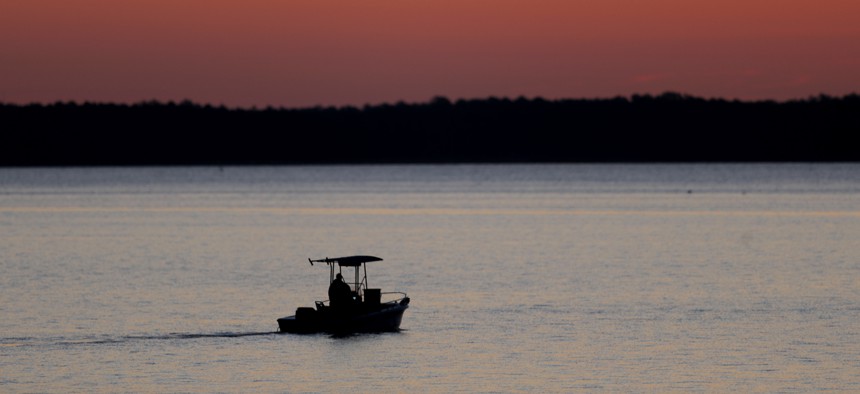States Sue EPA Over Chesapeake Bay Pollution Reduction Plans

In this May 14, 2020 photo, a small boat chugs along the Honga River near the Chesapeake Bay as the sky lights up at sunrise, in Fishing Creek, Md. AP Photo/Julio Cortez
A group of states say New York and Pennsylvania are not doing enough to reduce water pollution and arguing the federal government is letting them get away with it.
The Environmental Protection Agency is failing to enforce a multi-state pact to clean up the Chesapeake Bay by allowing two states to fall short of goals to reduce water pollution, according to a lawsuit filed this week by other states that border the nation’s largest estuary.
The litigation stems from an agreement signed by six states and Washington, D.C. to put pollution-reduction plans in place to meet certain water quality standards in the bay by 2025.
The states allege the EPA wrongly accepted plans for Pennsylvania and New York that do not adequately reduce the amount of nitrogen and phosphorus pollution.
Delaware, Maryland, Virginia and Washington, D.C. filed the suit in federal court Thursday. A second similar lawsuit was filed by the Chesapeake Bay Foundation, Maryland Watermen’s Association, and other advocacy organizations.
“The Chesapeake Bay is one of Virginia’s most important natural treasures and we all have a role to play in protecting and restoring it,” said Virginia Attorney General Mark Herring in a statement about the lawsuit. “The EPA must hold every partner equally accountable and make sure they uphold their portion of the agreement, but Trump’s EPA shirked that responsibility and simply rubber stamped inadequate plans.”
Excess nutrients and sediment that enter the bay through tributary rivers have harmed the overall health of the bay, creating algae blooms that can kill aquatic life like fish, crabs and oysters.
States within the watershed of the Chesapeake Bay entered into an agreement in 1983 to improve its water quality. Each state has had to submit a series of plans detailing how they would reduce pollution to meet the water quality goals in the allotted time.
While the EPA found that the plans submitted by Virginia, Maryland, Delaware, Washington, D.C. and West Virginia would meet the goals, the federal agency concluded that Pennsylvania and New York’s proposals would not, the lawsuit states. Despite this, the agency accepted the plans and did not make the states resubmit new compliant plans.
Pennsylvania’s latest plan would get the state only 75% toward its nitrogen reduction requirements by 2025, and New York’s plan would meet 66% of its goals, according to analysis of the plans done by the EPA.
“As a result of EPA’s regulatory retreat, Pennsylvania and New York will fall significantly short of their nutrient reduction goals and the long and difficult journey to restore the bay may end short of success,” the lawsuit states.
Neither Pennsylvania nor New York border the Chesapeake Bay, but a major bay tributary— Susquehanna River—flows through both states.
A spokeswoman for New York’s Department of Environmental Conservation said the state is responsible for 5% of the sediment and nutrient levels in the Chesapeake Bay, and said the state is fulfilling its clean water responsibilities under the multi-state agreement.
“EPA monitoring data confirms that if the quality of the water in Chesapeake Bay were as good as the water quality in New York’s portion of the Susquehanna River, the Chesapeake would not be impaired for nitrogen, phosphorus, or sediment,” said department spokeswoman Maureen Wren.
A spokesperson for Pennsylvania’s Department of Environmental Protection did not respond to a request for comment.
The EPA said the lawsuit would make it more difficult for the agency to work with states to improve the overall water quality in the Chesapeake Bay.
“This litigation only serves to set back our efforts, divert partnership resources and divide a partnership that is making exceptional advancement in restoring the Chesapeake Bay and local waters,” said EPA spokeswoman Molly Block.
The states’ lawsuit asks a federal court judge to order the EPA to set aside New York and Pennsylvania’s most recent watershed improvement plans and to develop new plans that will meet the pollution reduction goals.
Andrea Noble is a staff correspondent with Route Fifty.
NEXT STORY: Oregon Wildfires Prompt Evacuation Advisories for About 500,000





